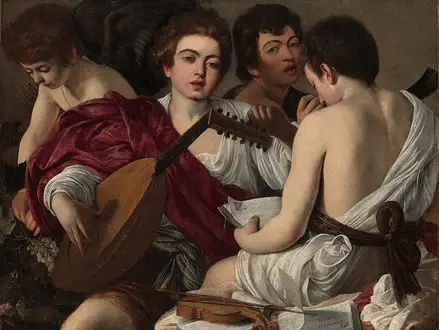Title of Artwork: “Musicians”

Artwork by Caravaggio
Year Created 1595
Summary of Musicians
Michelangelo Merisi da Caravaggio, the Italian artist of the Baroque style, is credited with painting The Musicians or Concert of Youths (c. 1595). (1571–1610). It has been housed at New York’s Metropolitan Museum of Art since 1952. In 1983, it received a meticulous restoration.
All About Musicians
By 1595, Caravaggio had joined the household of Cardinal Francesco Maria Del Monte, and it is believed that The Musicians was the first picture he created specifically for the cardinal.
According to the artist Baglione’s biography, the artist “created for the Cardinal youngsters playing music very well taken from nature and also a youth playing a lute,” the later painting likely being The Lute Player, which appears to be a companion piece to the earlier The Musicians.
Three of the lads are seen either playing or singing, while the fourth, costumed as Cupid, reaches towards a bunch of grapes; all four are clothed in what appears to be a quasi-Classical style of clothing.
It appears that Caravaggio used two separate figure studies to create this painting. The man in the centre playing the lute is thought to represent Caravaggio’s friend Mario Minniti, while the man on the right who is looking directly at the viewer may be the artist himself.
The cupid looks very much like the boy in the earlier work, Boy Peeling Fruit, and the angel in Saint Francis of Assisi in Ecstasy.
The boys may be seen performing love-themed madrigals in the manuscripts, and the main character, a lutenist, has tears in his eyes, suggesting that the songs focus more on the heartbreak of love than its joys.
There are four main figures in the scene, but the violin in the foreground suggests a fifth, the viewer.
Scenes featuring musicians were common during this period because the Church encouraged a musical renaissance and experimented with new styles and forms, especially among the more well-educated and forward-thinking clergy like Del Monte.
The scenario depicted here, however, is plainly secular rather than sacred, and it echoes the time-honored tradition of “concert” images, a type that emerged in Venice and is best represented by Titian’s Le concert champêtre.
Caravaggio’s most ambitious and intricate composition to date, the four figures don’t relate to each other or to the picture-space, and the overall result is quite awkward, suggesting the artist had trouble painting them independently.
Both the picture and the music in the manuscript have suffered from restorations in the past, but a tenor and an alto part are still discernible. Although there has been significant paint loss, the uniqueness of the piece has not been compromised in the least.
Information Citations:
En.wikipedia.org, https://en.wikipedia.org/.
























